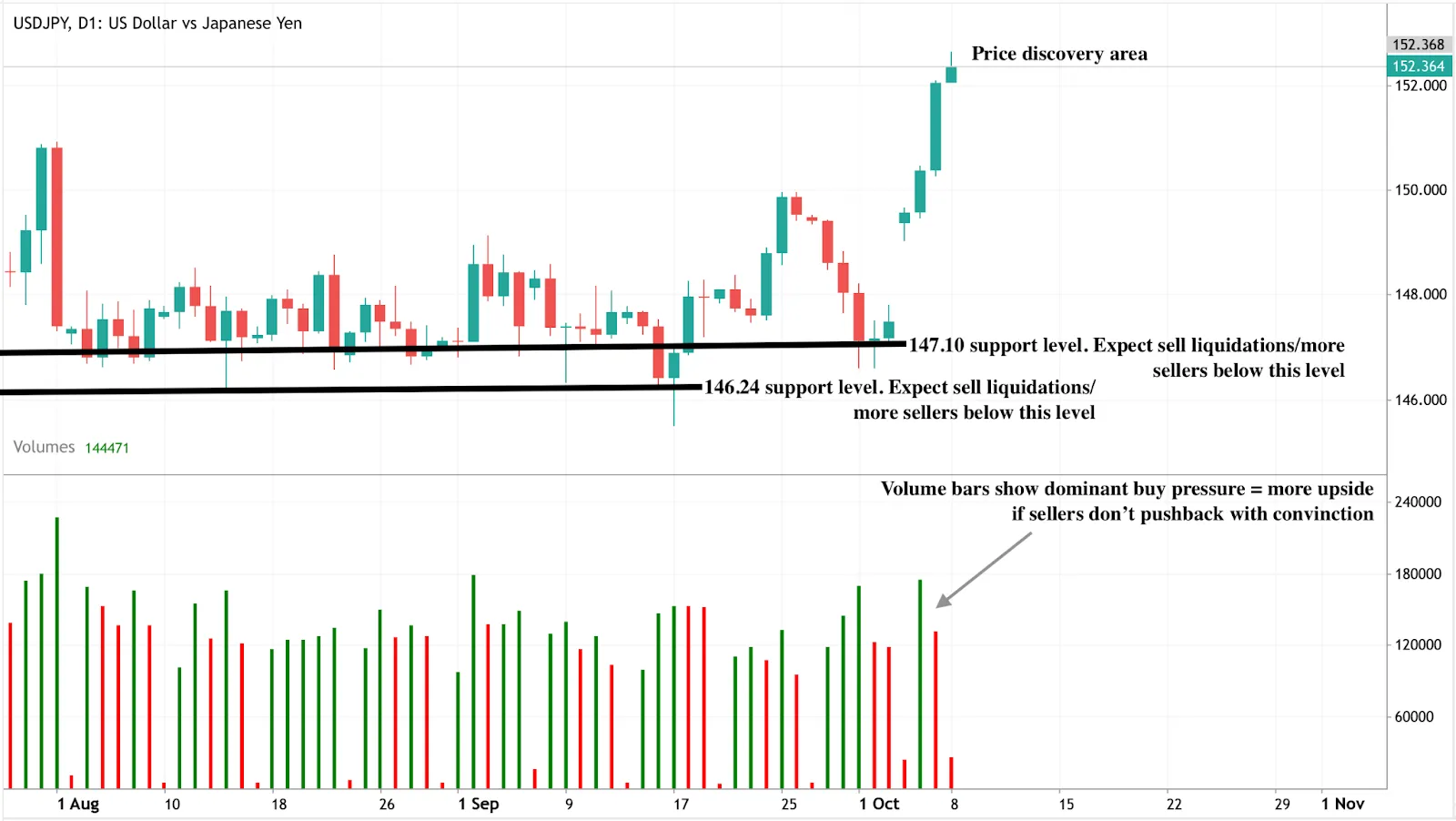Is Japan’s new stimulus era setting up the next yen carry trade boom?
Is Japan’s new stimulus era setting up the next yen carry trade boom?
Is Japan’s new stimulus era setting up the next yen carry trade boom?

Yes - Japan’s expansionary fiscal stance and persistently low interest rates are laying the groundwork for a renewed yen carry trade surge, according to analysts. With the yen sinking to a seven-month low and USD/JPY breaking above 151, traders are again borrowing yen to fund positions in higher-yielding assets. Tokyo now faces growing pressure to defend its currency as the market eyes 155 as the next key test. Unless the Bank of Japan (BoJ) tightens or the Ministry of Finance (MoF) intervenes, yen-funded trades could keep fuelling global risk appetite throughout 2025.
Key takeaways
- USD/JPY climbs past 151 - a seven-month high - as yen weakness extends amid risk-on sentiment.
- New Prime Minister Sanae Takaichi’s stimulus plans raise expectations of heavy spending and delay BoJ tightening.
- Yen carry trade activity expands, as investors borrow cheaply to access higher yields abroad.
- Tokyo warns of volatility, but traders continue testing Japan’s intervention limits.
- USD/JPY could reach 155 unless a coordinated fiscal and monetary response halts the move.
Japan’s forex intervention and the yen’s slide
Japan’s political transition has triggered a notable shift in investor sentiment. Following Sanae Takaichi’s election as the new leader of the Liberal Democratic Party (LDP), markets anticipate a return to large-scale fiscal stimulus aimed at reviving growth.
While this policy direction supports domestic demand, it has raised doubts over debt sustainability and may conflict with the BoJ’s inflation-targeting efforts. Japan’s inflation rate remains at 2.7% as of August, above the 2% target, suggesting policy tightening should continue - yet the opposite is happening.
Before the leadership change, traders expected a 0.75% BoJ policy rate by year-end. That forecast has now dropped to 0.26 probability, down from 0.60, reflecting a clear shift toward policy divergence.
Japan’s Inflation rate

This weaker policy outlook has made yen-denominated investments less appealing, accelerating capital outflows and currency depreciation.
Bank of Japan’s policy outlook
The BoJ’s ultra-cautious approach continues to anchor the yen. Despite global tightening, the central bank has been slow to raise rates - a contrast to peers in the U.S. and Europe.
Bank of Japan interest rates

This ongoing divergence has strengthened the USD/JPY pair, as traders see no imminent shift in Japan’s rate path.
The return of the yen carry trade
The yen carry trade - borrowing yen to buy higher-yield assets - has re-emerged as a dominant global strategy. With Japan’s rates near zero and liquidity abundant, traders are taking advantage of low borrowing costs to invest in higher-yielding markets such as the U.S. and Australia.
The backdrop for this trade is ideal: global stock markets remain strong, and investor appetite for risk is surging. The Nasdaq, S&P 500, and Nikkei 225 have all hit fresh highs, weakening demand for the yen as a safe-haven currency.
The last time these conditions aligned - in the mid-2000s - the yen became the world’s funding currency of choice. That cycle ended abruptly when the BoJ tightened unexpectedly. For now, however, fiscal stimulus and accommodative policy are keeping the carry trade alive.
Trading insight: The yen carry trade typically thrives when interest-rate spreads widen and market volatility stays low.
Tokyo’s dilemma: intervene or wait it out
Japan’s Ministry of Finance is again balancing credibility and control. With USD/JPY above 151, the risk of intervention grows, as previous efforts to stabilise the yen occurred near 150–152.
Finance Minister Katsunobu Kato has warned against “excessive volatility,” yet traders remain unconvinced. Without BoJ policy backing, currency intervention offers only temporary relief.
The result: speculative positioning continues to lean long on USD/JPY, while Tokyo faces the tough choice of either stepping in to buy yen or allowing the market to test its limits.
Insight for traders: Intervention risk often leads to wider spreads and higher volatility, so risk management and position sizing are crucial.
The U.S. factor: dollar strength despite domestic risks
The U.S. dollar remains resilient, even amid a government shutdown and rising expectations of Federal Reserve rate cuts. Markets price a 95% chance of a 25 bps cut in October and an 84% chance in December, but demand for dollar assets persists.
The DXY Index is trading above 98, underscoring the U.S. dollar’s safe-haven appeal relative to the yen.

This divergence reinforces the yen’s weakness, as even a stabilising dollar looks strong by comparison. Until Japan’s policy direction changes, USD/JPY remains structurally supported.
USD JPY forecast: What could change the trajectory?
Key developments that could alter the yen’s course include:
- A BoJ policy pivot: Any hawkish tone or rate adjustment could quickly lift the yen.
- Joint intervention: A coordinated MoF–BoJ effort could deliver a sharper rebound.
- A global risk-off shock: Equity corrections or geopolitical risks could revive safe-haven demand.
- Accelerated U.S. easing: Faster Fed cuts could narrow rate spreads and cap USD/JPY upside.
Without these catalysts, carry trade demand may continue dominating flows through late 2025.
USD/JPY technical insights: bulls target 155
At present, buy pressure dominates on the daily chart, with the pair in price discovery mode around 152.36. Volume indicators reflect strong bullish sentiment, while sellers lack the conviction to force a reversal.
If selling pressure builds, the yen could stage a rebound toward support at 147.10 and 146.24. However, continued bullish momentum may drive USD/JPY to 155, marking a potential new high for the year.

Technical takeaway: The trend remains bullish, but elevated volatility near intervention levels warrants careful leverage and margin management. Traders can track these levels using Deriv MT5’s advanced charting and analytical tools.
USD/JPY Investment Implications
For traders, policy divergence remains the key driver of USD/JPY’s moves.
- Short-term strategies: Buying on dips could remain viable while 151 holds as support. Monitor Tokyo’s rhetoric closely.
- Medium-term positioning: Flexibility is essential - any surprise from the BoJ could trigger a sharp reversal.
- Cross-market spillover: The yen carry trade is influencing equities, bonds, and commodity CFDs, reflecting the reach of Japan’s liquidity.
To calculate position sizing, margin requirements, or potential profit outcomes, use our forex trading calculator.
Unless Japan tightens policy soon, 2025 could mark the full revival of the global yen carry trade - extending a cycle of easy money and currency volatility.
The performance figures quoted are not a guarantee of future performance.















